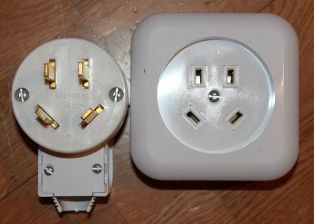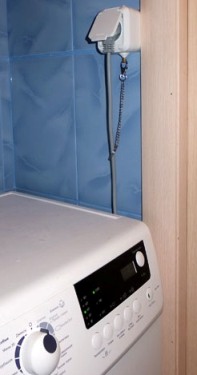Categories: Electrician at home, Electrical connection of equipment, Sockets and switches
Number of views: 75644
Comments on the article: 9
How to install and connect a socket for a stove and a washing machine
Choosing an outlet for a stove and a washing machine
 Outlet selection produced according to some basic operating parameters. Here they are:
Outlet selection produced according to some basic operating parameters. Here they are:
1. The number of phases required to power the electrical receiver, that is, its "phase". Anyway for three-phase connection you need a socket that has five connectors: L1, L2, L3, N and PE. A single-phase power supply is enough for a socket with three connectors: L, N and PE. Three-phase in our case can only be a stove, and even then only with the ability to connect to a three-phase network.
2. Rated current load on the socket. The passport of any device usually indicates electrical power, and data on the current drawn from the network may not be available. But on the contrary, electric power is never indicated on the body of electrical outlets - there is only data on the maximum permissible current.
Determining how many amperes your equipment consumes is not so difficult. Enough power, given in kilowatts, is multiplied by a thousand and divided by 220 (mains voltage). For a three-phase receiver, the result will need to be divided by another three. The resulting current value will be approximate, in reality it is slightly higher due to power factor.
The socket for connecting the device must be designed specifically for this or more current. In practice, the best option for a washing machine is a 16 amp Sсhuko socket. For a stove in a single-phase mode, a three-pin 40 amp plug is suitable, and in a three-phase mode, a five-pin 25 amp.
3. The necessary degree of protection of the outlet from external influences. For connecting plate a plug with a degree of protection IP20 is quite suitable, and for a washing machine, if it is installed in the bathroom, an outlet with protection according to IP44 will be needed.
4. Type of wiring. Outlets for outdoor installation can be used both in the case of open, and in the case of hidden wiring. But for hidden wiring, it is possible to use special outlets mounted inside the walls. For such outlets, frames are produced that allow you to make blocks that combine from two to five outlets and switches. True, this applies only to simple sockets without covers, not suitable for installation in the bathroom and in a three-phase network.
Installation of an external outlet for connecting an electric stove

Three-phase sockets, as well as sockets of high current rating, which fit perfectly into the hidden wiring, do not exist, therefore, to connect the plate we use an overhead socket.
To install such an outlet, you need a flat, hard surface. If the wall is wooden, then it is necessary to use some kind of insulating lining, for example, from textolite. The position of the outlet is checked by marking the cover and the inscriptions on it - they must be placed strictly horizontally.
If open wiring, then the cable starts through the groove on the top cover of the outlet, which usually needs to be broken into a suitable size with pliers. In the case of hidden wiring, the outlet is simply installed in the place where the cable goes out.
To fix the outlet to a concrete or brick wall, you can use the well-known pair of "plastic dowel - self-tapping screw". The diameter of the dowel should be five to six millimeters, no longer required. The number of mounting holes on three-phase and on single-phase sockets is usually the same - exactly two.
As mentioned above, to connect the cable cores to the connectors, you must be guided by the color coding of the cores and the marking on the cover of the socket.
Installing a washing machine outlet
 Since the power of household washing machines does not exceed 3 kW, ordinary Skhuko sockets with an earthing contact are used to connect them. Since the washing machine is usually installed in the bathroom, the outlet is usually used with special curtains that provide protection against splashes and drops.
Since the power of household washing machines does not exceed 3 kW, ordinary Skhuko sockets with an earthing contact are used to connect them. Since the washing machine is usually installed in the bathroom, the outlet is usually used with special curtains that provide protection against splashes and drops.
Such an outlet for outdoor installation has a one-piece plastic case, which is screwed to the wall with screws and dowels. A socket with a high degree of protection can be installed on a wooden wall without insulating linings thanks to a one-piece housing. For external cable entry, such a socket has a sealed notched cuff (gland), and a hidden cable entry can be made through holes in the bottom of the case.
To install a socket for hidden wiring, you will need a plastic socket (glass), mounted either in the void of the partition or in a blind hole in the wall. In the first case, a socket will be needed for hollow walls, and in the second - for solid ones. They differ in the presence of the first side clamps for fixing on the partition. The wall socket for a solid wall is fixed with alabaster or another quick-drying mixture.
To install any socket, you need a crown - a circular saw or a drill. If we are dealing with a solid concrete or brick wall, a crown will be needed in the diameter of the sapling (76 mm) for concrete and hammer drill. A punch hole pierces a blind hole, into which a plastic cup is placed.
With hollow partitions a little easier - the crown will be on wood, and it can be installed in a drill or screwdriver. The main thing is to make the hole gently, do not loosen it so that the socket will be fixed as reliably as possible.
Connecting cable cores to the terminals of the outlet is not a particularly difficult task. White (it can be brown) and blue (it can be white with a blue stripe) wires are connected to the working sockets, and the yellow-green wire is “planted” on the bar, which is located in the middle of the outlet and connected to the grounding “mustache”, in accordance with the standard Schuko.
Alexander Molokov
See also at i.electricianexp.com
:
